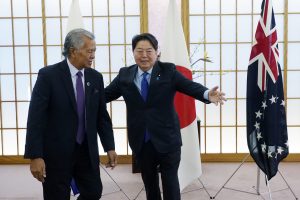The relationship between Japan and the Pacific Island countries (PICs) has been built through two approaches: bilateral and regional. A core element of the latter approach, the Pacific Island Leaders Meeting (PALM) has developed into a central platform for regional policy dialogue.
Since the 1960s, Japan’s bilateral relations with PICs have been built chiefly through fisheries relations and development cooperation. Relations with the region as a whole began in 1981 with the protest by the Pacific Islands Forum (PIF) against Japan’s plans to dump low-level nuclear waste into the ocean. The PIF was established in 1971 in protest against French nuclear tests, and nuclear issues are still today a very sensitive matter in the region.
In response to the PIF protests, Japan’s then Prime Minister Nakasone Yasuhiro visited Fiji in 1985 and pledged not to pursue the dumping plan. Two years later, in Fiji, then Foreign Minister Kuranari Tadashi announced the five principles, later recognized as the Kuranari Doctrine (respect for independence and autonomy, support for regional cooperation, ensuring political stability, expanding economic cooperation, and promoting people-to-people exchange), which form the foundation of PIC-Japan relations. Subsequently, the Sasakawa Peace Foundation organized Japan’s first ever Pacific Islands Conference in 1988, while the 1st Pacific Island Leaders Meeting (PALM1) was held in 1997.
The history of PALM can be divided into three periods. The first period was PALM1 (1997) to PALM3 (2003), serving as a critical period for the leaders of Japan and the PICs to build trust through direct dialogue.
The second period was from PALM4 (2006) to PALM6 (2012). During this time the PICs began to complain that the policy dialogue between leaders had become too routine, and grew less interested in listening to Japan’s offers of aid. This change in outlook reflected the fact that the PICs, long dependent on their former sovereign states, were accelerating their moves to secure their sovereignty and independence. As a result, the number of actors involved in the region increased, and the value of the PALM decreased. The destabilization of the PIF framework due to the coup d’état in Fiji and suspension of Fiji’s PIF membership also had an impact.
The third period was from PALM7 (2015) to PALM9 (2021). At PALM8 (2018), Japan succeeded in incorporating its vision of a Free and Open Indo-Pacific into the PALM Leaders Declaration as a policy initiative. Since then, Japan’s diplomacy with the PICs has been consistent, with the rule of law as its bedrock. While PALM9 (2021) was held online, Japan announced the Joint Action Plan for Strengthening Kizuna and Mutual Prosperity in the Pacific, which specifies 70 tangible goals for five priority areas (COVID-19 response and recovery, sustainable oceans based on the rule of law, climate change and disaster resilience, strengthening the foundation for sustainable and resilient economic development, and people-to-people exchanges and human resource development), and it evolved PALM into a platform leading to substantive action.
In the years since PALM9 (2021), the PIF has managed to avoid a breakup, the U.S.-Pacific Island Country Summit has been held, and the Partners in the Blue Pacific (PBP) framework for cooperation among developed countries has been established. Meanwhile, China’s forays into regional security issues and its increased involvement in the law enforcement sector, as well as concern about a Taiwan contingency, have increased geopolitical competition with the United States. Amid these developments, PALM remains a policy dialogue framework between Japan and PIF member countries and territories that has been in place for about 30 years, and PALM10 should concentrate on the relationship between Japan and the PICs, not allowing itself to be influenced by the U.S.-China geopolitical dynamic.
PALM10 will be the first face-to-face meeting of PIC leaders in Japan since 2018. In the six years since that meeting, face-to-face exchanges at the various levels of government have been disrupted by the COVID-19 pandemic. This has allowed misinformation to spread throughout the Pacific Island region, ignoring scientific data on Japan’s ALPS-treated water discharge plan and equating it with nuclear testing. The result has been an erosion of trust.
PALM10 will emphasize the alignment of Japan’s cooperation with the seven themes (political leadership and regionalism, people-centered development, peace and security, resources and economic development, climate change and disasters, ocean and environment, and technology and connectivity) included in the 2050 Strategy Implementation Plan, which was endorsed by the PIC leaders last November. The meeting will also emphasize cooperation to secure the rule of law, which is essential for regional prosperity and development, and encourage objective, science-based information sharing on the discharge of ALPS-treated water by the Japanese government.
PALM10 is an important opportunity to restore the kizuna (bond) between Japan and the PICs that has frayed in recent years, while laying the foundations for a partnership to tackle national, regional, and global challenges together. It is set to herald a new era in the relationship between Japan and Pacific Island countries, one that will last long into the future.
































